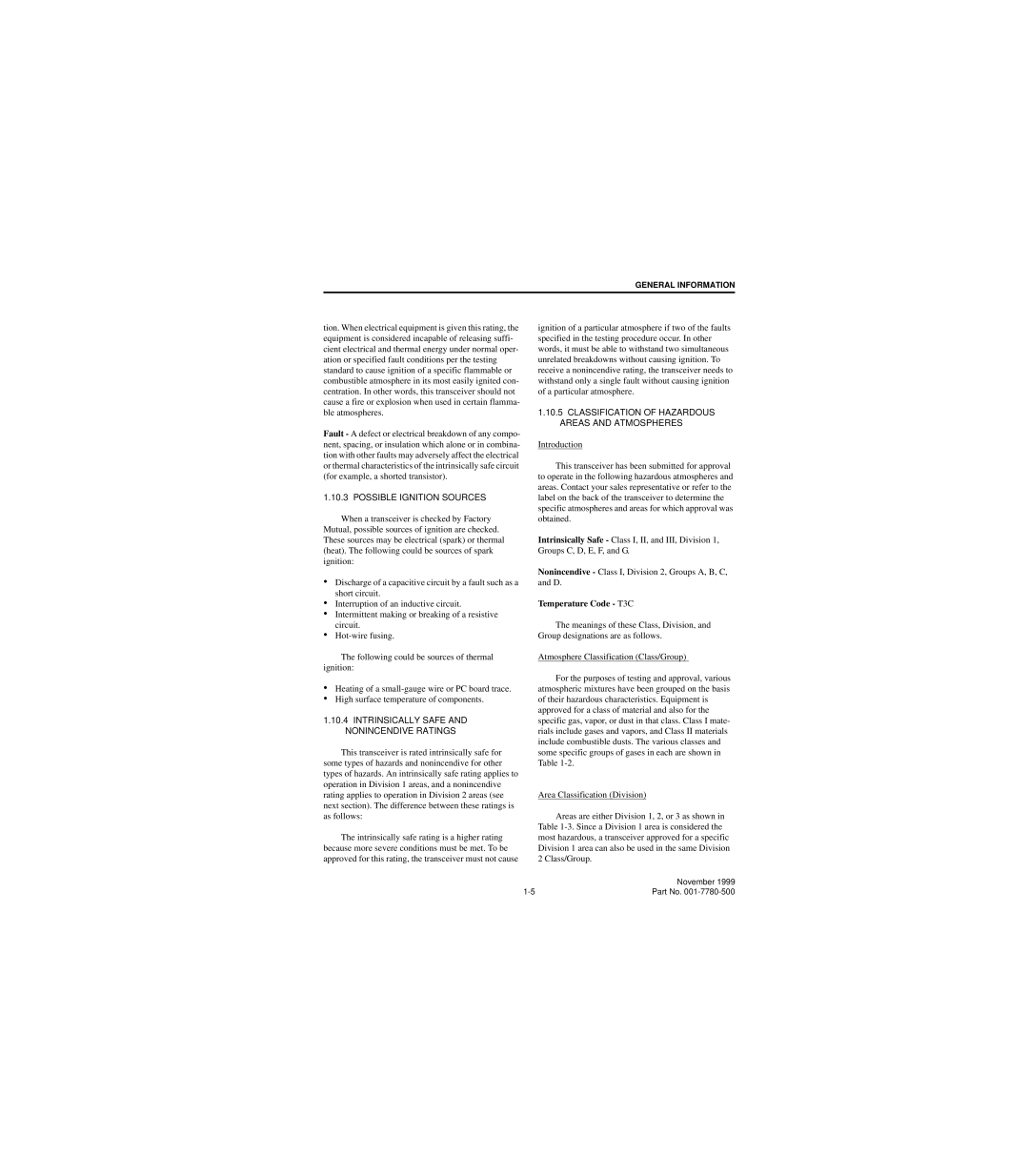
GENERAL INFORMATION
tion. When electrical equipment is given this rating, the equipment is considered incapable of releasing suffi- cient electrical and thermal energy under normal oper- ation or specified fault conditions per the testing standard to cause ignition of a specific flammable or combustible atmosphere in its most easily ignited con- centration. In other words, this transceiver should not cause a fire or explosion when used in certain flamma- ble atmospheres.
Fault - A defect or electrical breakdown of any compo- nent, spacing, or insulation which alone or in combina- tion with other faults may adversely affect the electrical or thermal characteristics of the intrinsically safe circuit (for example, a shorted transistor).
1.10.3 POSSIBLE IGNITION SOURCES
When a transceiver is checked by Factory Mutual, possible sources of ignition are checked. These sources may be electrical (spark) or thermal (heat). The following could be sources of spark ignition:
•Discharge of a capacitive circuit by a fault such as a short circuit.
•Interruption of an inductive circuit.
•Intermittent making or breaking of a resistive circuit.
•
The following could be sources of thermal ignition:
•Heating of a
•High surface temperature of components.
1.10.4INTRINSICALLY SAFE AND NONINCENDIVE RATINGS
This transceiver is rated intrinsically safe for some types of hazards and nonincendive for other types of hazards. An intrinsically safe rating applies to operation in Division 1 areas, and a nonincendive rating applies to operation in Division 2 areas (see next section). The difference between these ratings is as follows:
The intrinsically safe rating is a higher rating because more severe conditions must be met. To be approved for this rating, the transceiver must not cause
ignition of a particular atmosphere if two of the faults specified in the testing procedure occur. In other words, it must be able to withstand two simultaneous unrelated breakdowns without causing ignition. To receive a nonincendive rating, the transceiver needs to withstand only a single fault without causing ignition of a particular atmosphere.
1.10.5CLASSIFICATION OF HAZARDOUS AREAS AND ATMOSPHERES
Introduction
This transceiver has been submitted for approval to operate in the following hazardous atmospheres and areas. Contact your sales representative or refer to the label on the back of the transceiver to determine the specific atmospheres and areas for which approval was obtained.
Intrinsically Safe - Class I, II, and III, Division 1, Groups C, D, E, F, and G.
Nonincendive - Class I, Division 2, Groups A, B, C, and D.
Temperature Code - T3C
The meanings of these Class, Division, and Group designations are as follows.
Atmosphere Classification (Class/Group)
For the purposes of testing and approval, various atmospheric mixtures have been grouped on the basis of their hazardous characteristics. Equipment is approved for a class of material and also for the specific gas, vapor, or dust in that class. Class I mate- rials include gases and vapors, and Class II materials include combustible dusts. The various classes and some specific groups of gases in each are shown in Table
Area Classification (Division)
Areas are either Division 1, 2, or 3 as shown in Table
| November 1999 |
Part No. |
